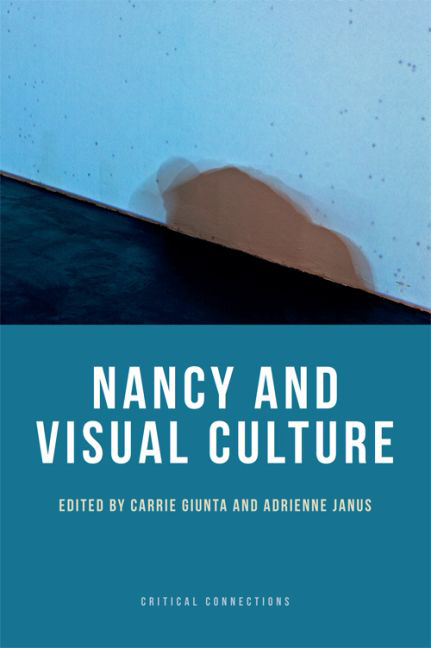Book contents
- Frontmatter
- Contents
- List of illustrations
- Acknowledgements
- Introduction: Jean-Luc Nancy and the Image of Visual Culture
- 1 Cutting and Letting-Be
- 2 Dancing Equality: Image, Imitation and Participation
- 3 A Question of Listening: Nancean Resonance, Return and Relation in Charlie Chaplin
- 4 The Image: Mimesis and Methexis
- 5 On the Threshold: Visual Culture, Invisible Nature
- 6 Pornosophy: Jean-Luc Nancy and the Pornographic Image
- 7 Presentation and Disappearance: Dialogue between Soun-Gui Kim and Jean-Luc Nancy
- 8 Writing in the Place of the Animal
- 9 Together at the Limit: Jean-Luc Nancy, Art and Community
- 10 Turning Around the Written Mark, Opening from a Weight of Thought
- 11 Uncanny Landscapes of Photography: The Partage of Double-Exposure after Jean-Luc Nancy
- Contributors
- Bibliography
- Index
1 - Cutting and Letting-Be
Published online by Cambridge University Press: 15 September 2017
- Frontmatter
- Contents
- List of illustrations
- Acknowledgements
- Introduction: Jean-Luc Nancy and the Image of Visual Culture
- 1 Cutting and Letting-Be
- 2 Dancing Equality: Image, Imitation and Participation
- 3 A Question of Listening: Nancean Resonance, Return and Relation in Charlie Chaplin
- 4 The Image: Mimesis and Methexis
- 5 On the Threshold: Visual Culture, Invisible Nature
- 6 Pornosophy: Jean-Luc Nancy and the Pornographic Image
- 7 Presentation and Disappearance: Dialogue between Soun-Gui Kim and Jean-Luc Nancy
- 8 Writing in the Place of the Animal
- 9 Together at the Limit: Jean-Luc Nancy, Art and Community
- 10 Turning Around the Written Mark, Opening from a Weight of Thought
- 11 Uncanny Landscapes of Photography: The Partage of Double-Exposure after Jean-Luc Nancy
- Contributors
- Bibliography
- Index
Summary
In a conversation with Philippe Lacoue-Labarthe published in 1992, Jean-Luc Nancy draws attention to a significant difference between himself and his close friend and long-time collaborator. Lacoue-Labarthe, says Nancy, prefers always to emphasise the paradoxical self-suspension of any figural inscription, the impossibility of the definitive accomplishment of which such figures might dream; whereas for his part, Nancy habitually points to the renewed invention operated by this same incompletion. ‘You tend always’, says Nancy,
[…] toward an effacement of the ‘figure’ […] whereas I feel myself continually led back to the exigency of a certain figuration, because the ‘interruption’ of myth does not appear to me to be a simple cessation, but a cutting movement which, in thus cutting, traces another place of articulation.
If this is a significant difference, it is also, as Nancy's language suggests, a question of two complementary tendencies, twin gestures peeling away from each other in response to a common movement – incomplete and incisive, inseparable and incompatible. Incomplete: the line cannot finally enclose what it is at once enclosing (and so ending, interrupting once and for all) and exposing to an outside its cutting is indicating as such. Incisive: this cutting is nonetheless creating a determinate figure, a kind of inside, however compromised; and the exposure of this kind-offigure to its constitutive outside both imperfectly closes its own epoch and opens the space – the time: the future – of another moment of possible figuration.
As we know, then, to trace a line is thus both to cut off, to circumscribe, to interrupt; and to open onto an inappropriable vacancy. To delimit. By definition set right up against this vacancy, the line may also invite its contemplation, its affirmation and perhaps even its maintenance: the incision may also be a form of care for this space beyond colonisation – better, for the spacing, the rhythm of differentiation which makes possible any movement and any presence whatsoever. This chapter considers the operation within Nancy's thought of just these two tendencies: the delineation of forms (here called cutting, despite and because of Nancy's ambivalence towards this term, as will be discussed) and the affirmation of the movement of presentation (which will here bear the Heideggerian name letting-be).
- Type
- Chapter
- Information
- Nancy and Visual Culture , pp. 21 - 38Publisher: Edinburgh University PressPrint publication year: 2016



